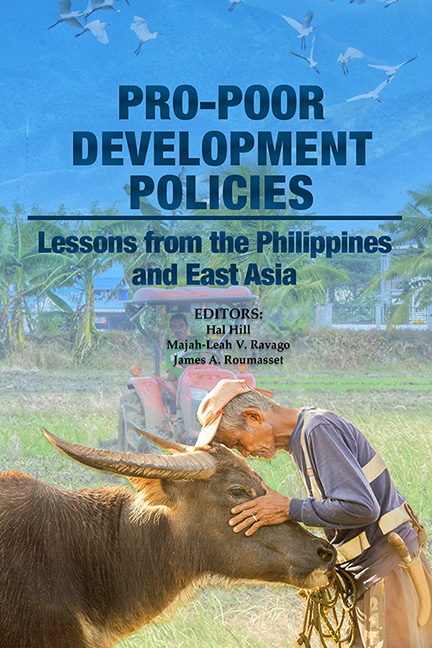Book contents
- Frontmatter
- Dedication
- Contents
- Figures, Tables and Boxes
- Foreword
- Foreword
- Message
- Preface and Acknowledgements
- About the Editors
- About the Contributors
- Acronyms
- Part 1 Introduction and Synthesis
- Part 2 Agricultural and Economic Development
- Part 3 Economic Policies for Achieving Targeted Levels of Living in the Philippines
- Part 4 Inequality and Economic Development
- Part 5 Competition Law and Policy
- Part 6 International Dimensions
- Index
13 - Collateralizing Wages: The Case of Sangla ATM
Published online by Cambridge University Press: 09 January 2024
- Frontmatter
- Dedication
- Contents
- Figures, Tables and Boxes
- Foreword
- Foreword
- Message
- Preface and Acknowledgements
- About the Editors
- About the Contributors
- Acronyms
- Part 1 Introduction and Synthesis
- Part 2 Agricultural and Economic Development
- Part 3 Economic Policies for Achieving Targeted Levels of Living in the Philippines
- Part 4 Inequality and Economic Development
- Part 5 Competition Law and Policy
- Part 6 International Dimensions
- Index
Summary
INTRODUCTION
Informal lending is one of the more common sources of household financing in many developing countries, including the Philippines. Informal finance arrangements through business counterparts and extended family members, pawnshops, rotating savings and credit associations (ROSCAs), and informal money lenders often prove more efficient than their formal counterparts around the globe (Adams and Hunter 2019). Despite the wide acceptance and integration into society of these informal financing institutions, studies on them are few, especially in the context of developing countries (see, e.g., Agabin et al. 1989; Agabin 1993; Nagarajan, David, and Meyer 1992; Floro and Ray 1997; Adams and Hunter 2019).
Surveys by the Bangko Sentral ng Pilipinas (BSP, Central Bank of the Philippines) point to a growing share of informal money lenders among households’ funding sources in recent years, despite the regulators’ push to encourage a more inclusive financial sector, such as utilizing microfinance institutions and digital banks and easing regulatory requirements to entice households to join the formal financial system (Karlan and Morduch 2010; Kritz 2013; BSP 2018, 2020). The 2019 Financial Inclusion Survey of the BSP shows that informal money lenders held a significant role in various financing decisions of households (BSP 2020).
The expansion of the informal financing channel does not refer only to the increased client base, but also to product innovations that money lenders introduce. For instance, collaterals accepted by money lenders have evolved from goods, jewelries, land titles and household appliances to, recently, automatic teller machine (ATM) or debit cards.
This study takes a close look at a newly emerged credit arrangement called Sangla ATM or debit card pawning. Sangla ATM is an informal loan arrangement where a borrower uses as collateral an ATM card linked to an account that receives a regular salary or other forms of income. The borrower surrenders the ATM card and its personal identification number to the lender, who then uses the card to withdraw the loan repayment (principal and interest) on a regular frequency (typically twice a month) until the entire amount is fully repaid.
The popularity of debit card pawning in the Philippines has reached a broad range of borrowers who have access to an ATM‑linked bank account—from conditional cash transfer recipients of the government to private-sector employees and even government personnel (ABS‑CBN 2018, 2020).
- Type
- Chapter
- Information
- Pro-poor Development PoliciesLessons from the Philippines and East Asia, pp. 339 - 358Publisher: ISEAS–Yusof Ishak InstitutePrint publication year: 2022

